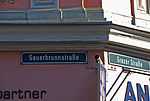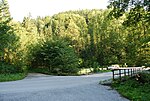Sauerbrunn (municipality of Stainz)
| Sauerbrunn ( scattered houses ) | ||
|---|---|---|
|
|
||
| Basic data | ||
| Pole. District , state | Deutschlandsberg (DL), Styria | |
| Judicial district | Deutschlandsberg | |
| Pole. local community | Stainz ( KG Trog ) | |
| Locality | trough | |
| District | trough | |
| Coordinates | 46 ° 55 '9 " N , 15 ° 11' 52" E | |
| height | 451 m above sea level A. | |
| Building status | 50 (2013) | |
| Post Code | 8510 Stainz | |
| prefix | + 43/3463 ( Stainz ) | |
| Source: STAT : index of places ; BEV : GEONAM ; GIS-Stmk | ||
Sauerbrunn is a place in the cadastral community Trog in the west of the community Stainz in Styria . It is located on the upper reaches of the Stainzbach in a narrow valley called the Sauerbrunngraben.
The name Sauerbrunn comes from the mineral springs that lie in the area and refers to the striking taste of the water from these springs. The name Sauerbrunn and the name Stainz are regarded as a Slavic-German double name in this context, because “Stainz” is also derived from a Slavic expression for a strikingly tasting spring.
There is a short story by Peter Rosegger about the mineral springs . Their (initially misunderstood) discovery is said to be due to one of two references that an old woman gave the miller of the (now derelict) Sommermichelmühle as thanks for giving her a measure (approx. 1.4 l) of rye flour (initially Called "Gesundbrunnen", the other reference concerned the Stainzer plates ).
Sauerbrunn is a scattered settlement without a central location. The area is largely covered by forest and only sparsely populated. It does not have the suffix "Bad".
“Bad Sauerbrunn” is the name given to the well system from which the water from the Archduke Johann spring flows. This spring is the most famous mineral spring in Sauerbrunn, it is recognized as a healing spring . There was a spa business with her.
In the literature, up to eight mostly very small sources of sour water are documented in the Sauerbrunn area. One of these springs is included in the current version of the Erzherzog-Johann-Quelle, another is in the bed of the Trogbach, others on the slopes of the surrounding mountains. A source is documented about 600 m as the crow flies in the valley of an unnamed left tributary of the Stainzbach.
The Wessenstein castle ruins are located in the southeast of Sauerbrunn . Sauerbrunn is the starting point for hikes in the northern Koralpe area, such as the Reinischkogel , the Sporiroa oven or the Mannagetta oven .
Sauerbrunn cannot be reached by public transport, the bus line leading there from Stainz from 1938 until GKB ceased operations consists only of school traffic from Stainz for the Marhof area (network line 746).
There are a number of places in Styria that are called "Sauerbrunn" or (in Lower Styria ) were. Places that were called "Sauerbrunn im Stainzthal" and which also have mineral water springs are also located in the Stainztal near Luttenberg (Ljutomer) in Slovenia. These places have nothing to do with Sauerbrunn near Marhof in western Styria, the name refers to the quality of the water. The Stainz River near Ljutomer bears the Slovenian name Ščavnica .
- Sauerbrunn (Stainz municipality), Styria
Web links
Individual evidence
- ↑ Fritz Lochner v. Hüttenbach: Styrian place names. On the origin and interpretation of names of settlements, mountains, waters and fields. In the series: Graz comparative works. Volume 21. Verlag Leykam Graz 2008. ISBN 978-3-7011-0116-0 . ZDB -ID 2083885-2 . Pp. 42, 49, 78.
- ^ Josef Georg Planinc: Bad Sauerbrunn: Project of a spa facility in the municipality of Marhof near Stainz (district of Deutschlandsberg). Diploma thesis at the Technical University of Graz 1990. S. 2.
- ↑ On the Rosegger year 2018 . In: Weststeirische Rundschau . No. 30, Volume 2018 (July 27, 2018), 91st Volume. ZDB -ID 2303595-X . Simadruck Aigner u. Weisi, Deutschlandsberg 2018, p. 7, with reference to the publication of the story Der Steinhansl in Tagespost No. 196, XIX. Vintage. August 29, 1874. pp. 1-2.
- ↑ Hilmar Zetinigg: The mineral and thermal springs of Styria. ( Memento of the original from November 8, 2014 in the Internet Archive ) Info: The archive link was inserted automatically and has not yet been checked. Please check the original and archive link according to the instructions and then remove this notice. (PDF; 43.3 MB) In: Communications from the Department of Geology and Paleontology at the Landesmuseum Joanneum. , Heft 50/51, Graz 1992/93. ZDB ID 1210191-6 . P. 198.
- ↑ Zetinigg: Mineral and thermal springs. P. 197.
- ^ Anton Reinbacher: 70 years of GKB - bus operation. (PDF; 1.0 MB) In: Drehscheibe, the staff magazine of Graz-Köflacher-Bahn- und Busbetriebe GmbH. No. 20, April 2005 (Abridged and expanded version of an article from "Omnibusspiegel" 1992). ZDB -ID 2181683-9 p. 2.
- ↑ Anton Franz Reibenschuh: The mineral springs and spas Styria. Pp. 27-28.
- ^ Mathias Macher: Overview of the medicinal waters and natural curiosities of the Duchy of Styria. Vienna, with Jakob Dirnböck, Graz with Carl Tendler. 1858. p. 8. (for copy see Commons).








